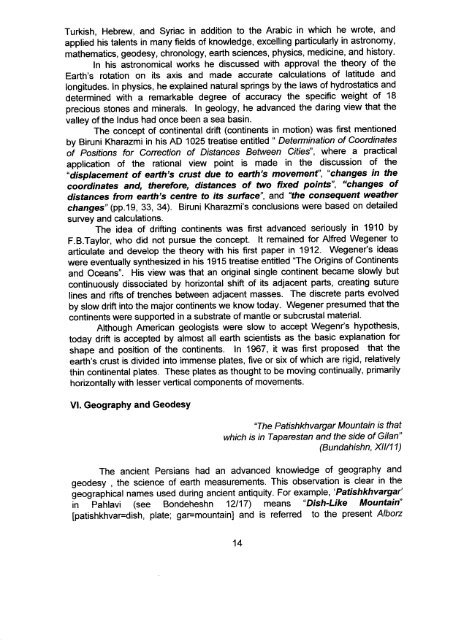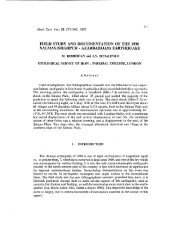PDF COPY - Manuel berberian
PDF COPY - Manuel berberian
PDF COPY - Manuel berberian
Create successful ePaper yourself
Turn your PDF publications into a flip-book with our unique Google optimized e-Paper software.
Turkish, Hebrew, and Syriac in addition to the Arabic in which he wrote, andapplied his talents in many fields of knowledge, excelling particularly in astronomy,mathematics, geodesy, chronology, earth sciences, physics, medicine, and history.In his astronomical works he discussed with approval the theory of theEarth's rotation on its axis and made accurate calculations of latitude andlongitudes. ln physics, he explained natural springs by the laws of hydrostatics anddetermined with a remarkable degree of accuracy the specific weight of 18preciou stones and minerals. In geology, he advanced the daring view that thevalley of the lndus had once been a sea basin.The concept of continental drift (continents in motion) was first mentionedby Biruni Kharazmi in his AD 1025 treatise entitled" Determination of Coordinateso,f Positions for Conection of Distances Between Cfties', where a practicalapplication of the rational view point is made in the discussion of the"displacement "changes Of earth's Crust due to eafth'S movemen(', in thecoordinates and, therefore, distances of two fixed poinb", "changes ofdistanceS from eatth'S Centre fo r'ts Surtace", and "the consequent weatherchanges" (pp.19, 33, 34). Biruni Kharazmi's conclusions were based on detailedsurvey and calculations.The idea of drifting continents was first advanced seriously in 1910 byF.B.Taylor, who did not pursue the concept. lt remained for Alfred Wegener toarticulate and develop the theory with his first paper in 1912. Wegener's ideaswere eventually synthesized in his 1915 treatise entitled"The Origins of Continentsand Oceans". His view was that an original single continent became slowly butcontinuously dissociated by horizontal shift of its adjacent parts, creating suturelines and rifts of trenches between adjacent masses. The discrete parts evolvedby slow drift into the major continents we know today. Wegener presumed that thecontinents were supported in a substrate of mantle or subcrustal material-Although American geologists were slow to accept Wegenr's hypothesis,today drift is accepted by almost all earth scientists as the basic explanation forshape and position of the continents. ln 1967, it was first proposed that theearth's crust is divided into immense plates, five or six of which are rigid, relativelythin continental plates. These plates as thoughto be moving continually, primarilyhorizontally with lesser vertical components of movements.Vl. Geography and GeodesY"The Patishkhvargar Mountain is thatwhich is in Taparestan and the side of Gilan"(Bundahishn, XII/11)The ancient Persians had an advanced knowledge of geography andgeodesy , the science of earth measurements. This observation is clear in thegeographical names used during ancient antiquity. For example,'Patishkhvargalr. Pahlavi (see Bondeheshn 12t17) means "Dish-Like Mountain"[patishkhvar=dish, plate; gar=mountain] and is referred to the present Alborz14







